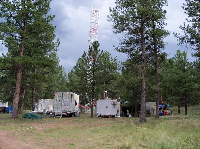Exploring the role of nitrogen chemistry in the forest atmosphere during the BEACHON-Rocky Mountain Biogenic Aerosol Study
Nitrogen oxides, through their interactions with volatile organic compounds (VOCs), NH3, OH, and other gas-phase species, exert important controls on the lifetime and fate of atmospheric VOCs and the formation of secondary aerosol. During the night, the nitrate (NO3) radical is an important oxidant, reacting rapidly with unsaturated VOCs, many of which are biogenic in origin (BVOC), to produce organic nitrates and other oxidized VOCs, some of which lead to the formation of secondary organic aerosol. This NO3-BVOC reaction pathway could play a dominant role in the formation of aerosol in forested regions, such as the Colorado Front Range.

Figure 1. Manitou Forest Observatory chemistry tower during the BEACHON-RoMBAS Campaign.
Since summer 2011, Prof. Juliane (Julie) Fry, from Reed College in Portland, OR, and Jim Smith, scientist in ACD, joined forces to explore the role of NO3-BVOC chemistry on aerosol formation. Julie is spending her sabbatical year in Boulder, funded by NCAR’s ASP Faculty Fellowship Program and by a NOAA CIRES Fellowship. To accomplish this task, Julie has created a team of researchers that includes ACD, NOAA ESRL (Dr. Steve Brown and colleagues), Reed College (Julie and her undergraduate student, Danielle Draper), and UC Berkeley (Prof. Ron Cohen’s research group).
Their work started in July and August 2011, when the BEACHON Rocky Mountain Biogenic Aerosol Study (BEACHON-RoMBAS) field campaign took place at NCAR’s Manitou Forest Observatory in Woodland Park, CO. The Bio-hydro-atmosphere Interactions of Energy, Aerosols, Carbon, H2O, Organics, and Nitrogen (BEACHON) project is a long-term, multi-institution, collaborative research program, spearheaded by NCAR, to advance understanding of bio-hydro-atmosphere interactions and feedbacks for incorporation into future earth system models. During BEACHON-RoMBAS, over 30 principle investigators and twice that number of support staff, students, and postdocs converged on Manitou Forest to understand the ways by which particles are created in the forest and how they may regulate and link the biogeochemical and water cycles.

Figure 2. Diurnal trends of gas and aerosol phase organic nitrates during BEACHON-RoMBAS (top): NO2 (blue), peroxynitrates (green), and alkylnitrates (red); (bottom): total organic nitrates (red), aerosol-phase only organic nitrates (brown), and fraction of organic nitrates in the aerosol phase (black).
A summary of Julie’s observations of gas and aerosol phase organic nitrates is shown in the plot. While total organic nitrates peak during the day, presumably from photochemical production, aerosol-phase organic nitrates peak at night, suggesting that nighttime NO3-initiated chemistry produced lower-volatility nitrates that readily form aerosol. Directly following the campaign, the research team brought their instruments back to NCAR for some follow-up studies of particle formation and growth from nitrate radical oxidation. While Julie and her team are still analyzing their measurements, it is already clear that BEACHON-RoMBAS will provide many unique insights into the role of nitrogen oxides in the forest atmosphere.
Keywords: atmospheric chemistry, community laboratory, ACD, NCAR, NOAA ESRL, Ultrafine Aerosols Group, Biosphere-Atmosphere Interactions Group
References:
Emissions and ambient distributions of Biogenic Volatile Organic Compounds (BVOC) in a Ponderosa pine ecosystem: interpretation of PTR-MS mass spectra, S. Kim, T. Karl, A. Guenther, G. Tyndall, J. Orlando, P. Harley, R. Rasmussen, and E. Apel, ACP, 2009.
Fry et al., “Observations of gas- and aerosol-phase organic nitrates at BEACHON-RoMBAS 2011,” in preparation, ACP, 2012.
